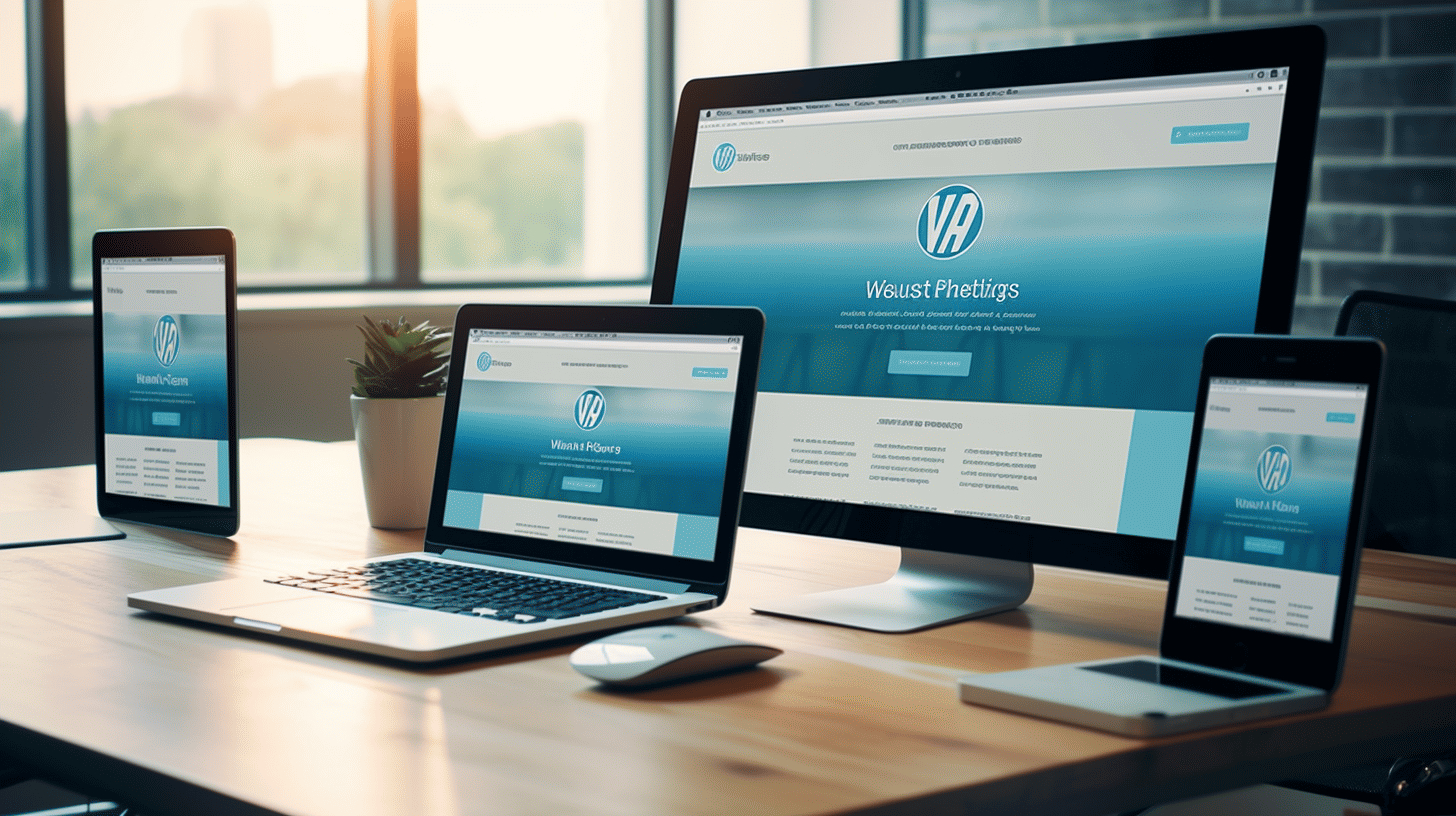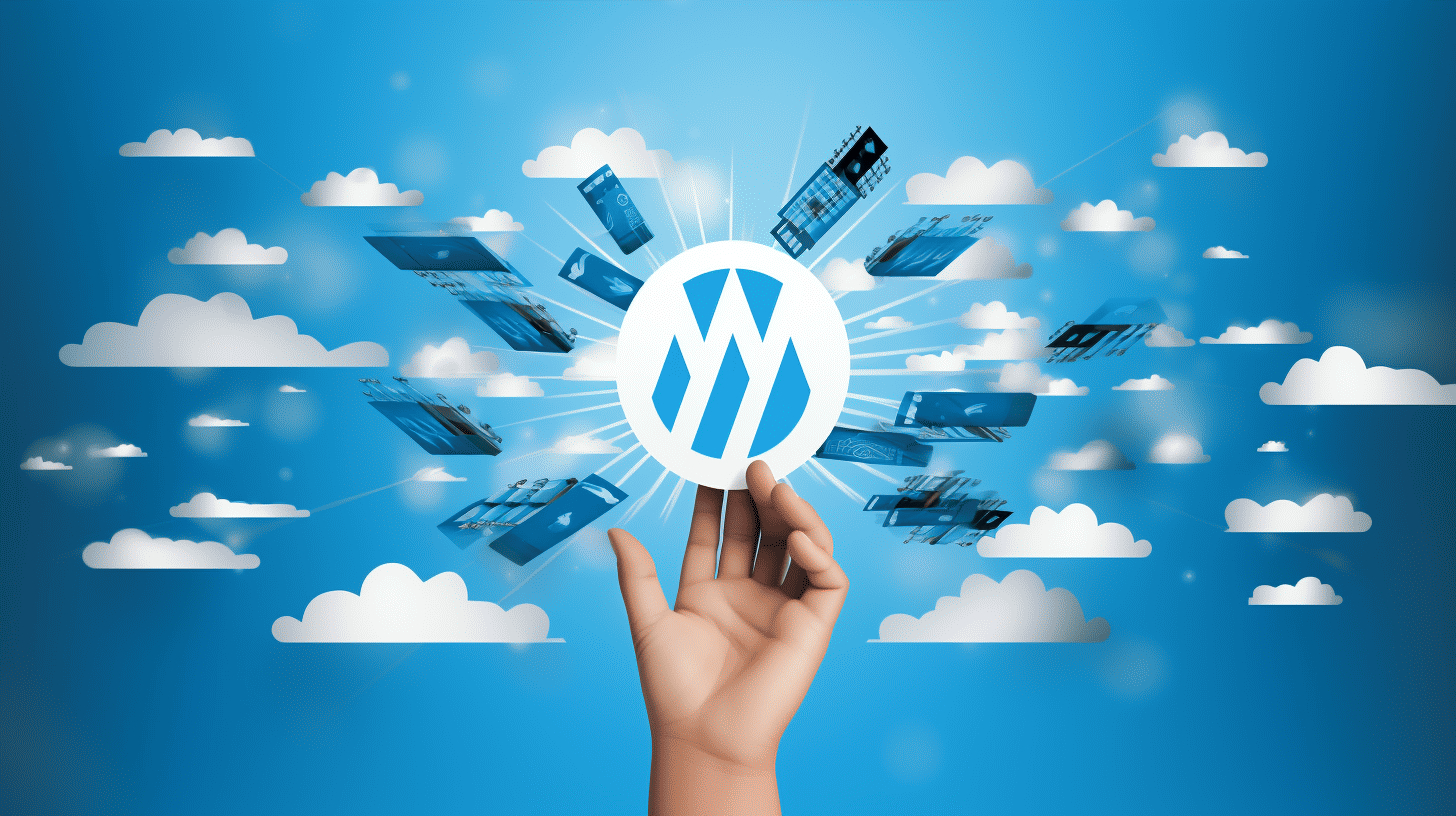對於任何希望建立強大的線上形象並吸引客戶的企業主來說,創建專業的網站至關重要。最受歡迎的網站建立平台之一是 WordPress。 WordPress 憑藉其用戶友好的介面、豐富的主題和外掛程式選擇以及客製化靈活性,已成為全球專業人士的首選。
在本文中,我們將探討使用 WordPress 建立商業網站的好處,並為您提供建立專業 WordPress 網站的重要技巧。我們還將討論內容管理、網站維護和安全的最佳實踐,以確保您的網站發揮最佳效能。
無論您是小型企業主還是企業家,本文都將為您提供使用 WordPress 創建強大且專業的線上形象所需的知識和工具。那麼讓我們深入挖掘並釋放您網站的全部潛力吧! 🚀
WordPress 的流行
WordPress 無疑已成為數位領域最受歡迎的內容管理系統 (CMS) 之一。其用戶友好的介面、豐富的功能和廣泛的社區支援使其成為企業和個人的首選。在本節中,我們將探討 WordPress 的使用統計數據和市場份額,揭示其廣泛採用和持續成長。
WordPress 使用統計
根據最新數據顯示,目前已有超過 63.5% 的知名 CMS 網站使用 WordPress,顯示出其在市場上的主導地位。這個驚人的數字證明了該平台的多功能性和易用性。無論您經營的是個人部落格、電子商務商店還是公司網站,WordPress 都能提供靈活性和可擴展性來滿足您的需求。
讓WordPress更加令人印象深刻的是其持續的成長率。隨著年復一年超過 10% 的成長,越來越多的企業選擇 WordPress 作為首選 CMS。這種增長可以歸因於多種因素,包括:
- 易於使用: WordPress 的直覺式介面和使用者友善功能使具有所有技術背景的個人都可以使用它。這種易用性在其快速採用中發揮了重要作用。
- 插件生態系: WordPress 擁有豐富的外掛程式庫,使用者可以透過附加功能和功能來增強他們的網站。無論是 SEO 優化、社群媒體整合還是電子商務功能,幾乎每個需求都有相應的插件。
- 社區支持: WordPress 社群是一個充滿活力和熱情的開發人員、設計師和愛好者群體,他們為 WordPress 的持續發展和支援做出了貢獻。這個生態系統確保用戶能夠訪問豐富的資源、教程和論壇,從而更容易解決問題並改進他們的網站。
市場佔有率和成長
WordPress 的市佔率充分說明了它在網站所有者和開發人員中的受歡迎程度。目前,網路上超過 43% 的網站都由 WordPress 提供支持,遙遙領先於其他 CMS。如此巨大的市場份額證明了企業對 WordPress 作為一個可靠且強大的平台的信任和信心。
此外,WordPress 在 CMS 網站中佔有驚人的 64.2% 市場。這意味著大多數使用 CMS 的企業和個人都選擇 WordPress 作為他們的首選。這種程度的主導地位清楚地表明了 WordPress 相對於其競爭對手的優勢,並展示了其無與倫比的可擴展性和可靠性。
總而言之,WordPress 的流行並非沒有道理。它的易用性、廣泛的插件生態系統和強大的社區支持使其成為 CMS 行業的頂尖企業。隨著 WordPress 的持續成長和廣泛採用,它沒有絲毫放緩的跡象。無論您是初學者還是經驗豐富的開發人員,WordPress 都提供了強大且可自訂的平台來創建令人驚嘆的網站。
使用 WordPress 建立商業網站的好處
在當今數位時代,擁有強大的線上影響力對於各種規模的企業都至關重要。精心設計的網站可以作為強大的行銷工具,吸引客戶並展示您的產品或服務。在建立專業網站方面,WordPress 成為領先的平台之一。 WordPress 擁有用戶友好的介面、靈活性以及豐富的主題和外掛程式選擇,為企業提供了無數好處。無論您是小型新創公司還是大型公司,以下是一些應該選擇 WordPress 來建立您的商業網站的原因。
使用者友善的介面
WordPress 的主要優勢之一是其直覺且用戶友好的介面。您無需成為編碼專家或擁有豐富的技術知識即可使用 WordPress 建立和管理您的網站。該平台旨在讓每個人都可以訪問,即使是初學者也可以輕鬆瀏覽和自訂他們的網站。透過其簡單直接的儀表板,您可以輕鬆新增頁面、發布部落格文章、上傳圖像以及更新網站內容。 WordPress 讓網站管理變得輕而易舉,使企業主能夠完全控制他們的線上狀態。
靈活且可客製化
WordPress 的另一個突出特點是其令人難以置信的靈活性和自訂選項。無論您是企業主、設計師還是開發人員,WordPress 都能提供工具和資源來實現您的願景。平台提供廣泛的主題、模板和佈局,讓您可以選擇符合您的品牌形象的完美設計。此外,WordPress 強大的外掛程式生態系統可讓您只需單擊幾下即可為您的網站添加高級功能。無論您需要電子商務功能、SEO 優化還是社交媒體集成,幾乎每個需求都有插件。使用 WordPress,您可以自由創建真正代表您業務的獨特網站。
豐富的主題和外掛選擇
WordPress 擁有數千種主題和插件,可提供無與倫比的選項來增強您的商業網站。無論您是在尋找時尚專業的設計還是大膽創意的佈局,您都會找到適合您風格的主題。主題可讓您快速更改網站的外觀和感覺,而無需複雜的編碼。最重要的是,外掛程式可以擴展您網站的功能,使您能夠添加功能並優化效能。從聯絡表單和分析工具到圖像滑桿和社交媒體按鈕,借助 WordPress 豐富的主題和外掛程式選擇,您可以實現幾乎無限的功能。
總之,對於希望建立強大而有效的線上形象的企業來說,WordPress 是最佳選擇。其用戶友好的介面、靈活性以及豐富的主題和插件選項使其成為適合各種規模企業的多功能平台。無論您是精通科技的企業家還是網站開發的新手,WordPress 都能提供工具和資源來建立符合您業務目標的專業且可自訂的網站。那麼,為何要等待呢?利用 WordPress 的強大功能,將您的業務在網路上推向新的高度。 🚀
創建專業 WordPress 網站的基本技巧
創建專業的 WordPress 網站並不一定是一件非常困難的事情。透過正確的技巧和策略,您可以建立一個不僅外觀精美而且功能齊全的網站。在本文中,我們將探討一些基本技巧,幫助您建立一個脫穎而出的專業 WordPress 網站。
定義您的網站目標
在深入設計和開發過程之前,確定您的網站目標至關重要。此步驟將幫助您確定網站的設計和功能要求。花一些時間考慮以下問題:
- 您的網站的目的是什麼?是為了展示您的產品組合、銷售產品還是提供資訊?
- 你的目標受眾是誰?他們的需求和期望是什麼?
- 您希望訪客在您的網站上採取什麼行動?您希望他們訂閱電子報、進行購買或聯絡您以獲取更多資訊嗎?
透過明確定義您的網站目標,您可以建立一個有效傳達您的訊息並吸引您的受眾的網站。
選擇合適的託管服務提供者
在託管您的 WordPress 網站時,選擇合適的託管服務提供者至關重要。可靠的託管服務提供者可確保您的網站運作良好且保持安全。選擇託管服務提供者時需要考慮以下幾個因素:
- 速度和效能:尋找提供快速載入時間和可靠正常運作時間的供應商。
- 安全性:確保託管服務提供者採用強大的安全措施來保護您的網站免受潛在威脅。
- 可擴展性:選擇一家可讓您隨著業務成長輕鬆擴展網站的託管服務提供者。
- 客戶支援:選擇提供響應式客戶支援的託管服務供應商,以便在您遇到任何問題時為您提供協助。
透過選擇正確的託管服務提供者,您可以確保您的網站順利運作並為您的訪客提供無縫的瀏覽體驗。
選擇高品質主題
網站的視覺吸引力和用戶體驗對於給人留下良好的第一印象起著至關重要的作用。實現此目的的一種方法是為您的 WordPress 網站選擇一個高品質的主題。選擇主題時請考慮以下因素:
- 響應式設計:確保主體適合行動裝置並適應不同的螢幕尺寸。
- 自訂選項:尋找一個提供足夠靈活性的主題來客製化設計以符合您的品牌標誌。
- 程式碼品質:選擇具有乾淨且結構良好的程式碼的主題以確保最佳效能。
- 相容性:確保主題與最新版本的 WordPress 和流行外掛程式相容。
精心設計的主題不僅可以增強您網站的視覺吸引力,還可以為您的訪客提供無縫的瀏覽體驗。
安裝必備插件
WordPress 外掛程式為您的網站添加功能並增強其效能。以下是每個專業 WordPress 網站都應該具備的一些基本外掛程式:
- SEO外掛程式:安裝SEO外掛程式來優化您的網站以適應搜尋引擎並提高其可見性。
- 安全插件:透過安裝提供惡意軟體掃描和防火牆保護等功能的安全插件來增強您網站的安全性。
- 備份外掛:使用可靠的備份外掛程式定期備份資料來保護您的網站。
- 聯絡表單插件:透過在您的網站上新增聯絡表單插件,讓您的訪客可以輕鬆與您聯絡。
透過安裝這些必備的插件,您可以確保您的網站具有必要的功能並實現最佳效能。
針對 SEO 優化您的網站
針對 SEO(搜尋引擎優化)優化您的 WordPress 網站對於提高其知名度和推動自然流量至關重要。以下是一些值得遵循的 SEO 技巧:
- 進行關鍵字研究並使用相關關鍵字來優化您的內容。
- 優化您的元標籤,包括標題標籤和元描述。
- 創建高品質、引人入勝的內容,為您的訪客提供價值。
- 透過壓縮圖像和利用快取來提高網站的載入速度。
- 確保您的網站適合行動裝置且反應迅速。
透過實施這些 SEO 策略,您可以提高網站在搜尋引擎結果頁面上的排名並吸引更多自然流量。
總之,創建專業的 WordPress 網站需要仔細規劃並專注於細節。透過定義您的網站目標,選擇合適的託管服務提供商,選擇高品質的主題,安裝必要的插件以及針對 SEO 優化您的網站,您可以創建一個不僅看起來專業而且還為您的訪客提供無縫瀏覽體驗的網站。祝網站建置愉快!
WordPress 內容管理的最佳實踐
組織您的內容
當談到管理 WordPress 上的內容時,組織是關鍵。結構良好的網站不僅可以改善使用者體驗,還可以幫助搜尋引擎更有效地理解和索引您的內容。以下是組織內容的一些最佳做法:
- 建立邏輯站點結構: 將您的內容分為相關的類別和子類別,以便訪客更輕鬆地導航。這有助於他們快速找到所需的資訊並改善整體用戶體驗。
- 使用直覺的導航選單: 確保您的網站的導航選單清晰、簡潔且易於導航。為每個選單項目使用描述性標籤,讓使用者了解點擊該選單項目時可以找到什麼。
- 使用標籤和關鍵字: WordPress 可讓您為您的貼文分配標籤,就像關鍵字一樣,有助於對您的內容進行分類和識別。使用相關標籤準確代表您的貼文中討論的主題。這使得搜尋引擎更容易理解您的內容,並有助於提高您的網站在搜尋結果中的可見性。
- 建立 XML 網站地圖: XML 網站地圖是一個列出您網站上所有頁面的檔案。它可以幫助搜尋引擎更有效地發現和索引您的內容。 Yoast SEO 等 WordPress 外掛程式可以自動為您產生 XML 網站地圖。
- 使用麵包屑: 麵包屑是一種導航輔助工具,可以向使用者顯示他們在您網站上的目前位置。它們可以幫助訪客了解網站的結構並允許他們輕鬆地向後導航。 Yoast SEO 等 WordPress 外掛程式提供了您可以在您的網站上啟用的麵包屑功能。
請記住,在組織內容時,請優先考慮受眾的需求。想想他們將如何瀏覽您的網站以及他們最有可能搜尋什麼資訊。透過遵循這些最佳實踐,您可以創建一個用戶友好且組織良好的網站,訪客和搜尋引擎都會喜歡。
創造引人入勝的高品質內容
除了組織您的內容之外,創建能夠引起觀眾共鳴的引人入勝的高品質內容也至關重要。以下有一些技巧可以幫助你實現這個目標:
- 了解你的受眾: 了解您的目標受眾是誰以及他們正在尋找什麼。進行研究,分析您的網站分析,並透過評論和社交媒體與您的受眾互動以收集見解。這將幫助您創建滿足他們的需求和興趣的內容。
- 撰寫引人注目的標題: 吸引人的標題是吸引讀者註意力的第一個機會。使其清晰、簡潔、有趣,以吸引用戶點擊並進一步閱讀。
- 精心製作結構良好的內容: 將內容分成幾個部分並使用副標題,以便讀者更輕鬆地瀏覽並找到他們正在尋找的資訊。在適當的時候使用項目符號和編號清單來提供清晰簡潔的資訊。
- 添加視覺效果: 在內容中加入圖像、資訊圖表和影片不僅可以使其更具視覺吸引力,而且還有助於更有效地傳達訊息。使用 alt 標籤來優化您的圖像以適應搜尋引擎。
- 校對和編輯: 在發佈內容之前,請務必校對文法和拼字錯誤。編輯對於確保內容流暢和有效傳達訊息至關重要。
透過創建引人入勝的高品質內容,您可以吸引忠實的受眾,提高網站的知名度,並確立自己在行業中的權威地位。
優化圖片和媒體文件
優化您的圖像和媒體檔案對於提高您網站的效能和使用者體驗至關重要。以下是在 WordPress 上優化圖像和媒體檔案的一些最佳做法:
- 選擇正確的文件格式: 對您的影像使用合適的文件格式。 JPEG 最適合照片,而 PNG 則非常適合具有透明度的圖形和影像。使用 GIF 作為動畫圖像。
- 調整影像大小並壓縮: 將圖片大小調整為網站所需的尺寸,以避免檔案大小不必要地過大。使用 Smush 或 EWWW Image Optimizer 等圖像壓縮插件來減少檔案大小而不影響品質。
- 添加描述性 alt 標籤: Alt 標籤為視障用戶提供替代文本,並幫助搜尋引擎了解圖片的內容。在您的 alt 標籤中使用描述性和相關的關鍵字來優化您的圖像以適應搜尋引擎。
- 延遲載入圖片: 延遲載入是一種延遲圖像和媒體檔案的載入直到它們在使用者螢幕上可見的技術。這有助於提高頁面載入時間和整體網站效能。
- 考慮一個內容分發網路(CDN): CDN 將您網站的靜態檔案(包括圖像和媒體檔案)儲存在全球多個伺服器上。這縮短了您的網站和訪客之間的距離,從而縮短了載入時間。
透過優化您的圖像和媒體文件,您可以增強您網站的效能,改善用戶體驗,並可能提高您的搜尋引擎排名。因此請確保不要忽略 WordPress 內容管理的這一重要方面。
WordPress 網站維護和安全
在當今數位時代,維護 WordPress 網站的安全至關重要。隨著網路威脅和漏洞的不斷增加,優先進行定期更新、備份和復原以及增強網站安全性以確保您的線上安全至關重要。在本節中,我們將深入探討 WordPress 網站維護和安全的三個關鍵方面,並為您提供可行的提示,以確保您的網站安全和受到保護。
定期更新
保持你的 WordPress 網站更新是增強安全性和減少漏洞的最有效方法之一。定期更新不僅引入新功能,還可以解決任何已知的安全性問題。以下是您應該優先考慮定期更新 WordPress 網站的一些令人信服的理由:
- 提高安全性:每次更新通常包含解決已知漏洞的安全性修補程式和修復程式。透過及時安裝更新,您可以領先潛在駭客一步。
- 增強功能:更新通常會帶來新功能和效能改進,可增強您網站的功能和使用者體驗。
- 與外掛程式和主題的兼容性:更新 WordPress 可確保您的網站與最新版本的外掛程式和主題相容,從而降低衝突或相容性問題的風險。
專業提示: 為您的 WordPress 網站設定自動更新以簡化流程並確保您不會錯過任何更新。
備份與復原
無論您的網站的安全措施有多強大,事故仍然可能發生。這就是為什麼建立可靠的備份和復原系統至關重要。以下是您應該優先備份 WordPress 網站的原因:
- 防止資料遺失:定期備份可確保您擁有網站檔案和資料庫的副本,以防因駭客攻擊、伺服器問題或其他不可預見的情況而導致任何資料遺失。
- 輕鬆復原:透過適當的備份系統,您可以在發生安全漏洞或任何其他重大問題時快速有效地還原您的網站。
專業提示: 定期測試您的備份和恢復過程,以確保其順利運行並且您可以在需要時依賴它。
增強網站安全性
保護您的 WordPress 網站應該是首要任務,以保護您的資料和訪客的資訊。以下是一些需要考慮的基本安全措施:
- 強密碼:確保您和您的用戶擁有強而獨特的密碼,以最大限度地降低暴力攻擊的風險。
- 雙重認證 (2FA):實施 2FA 為您的登入流程增加額外的安全層。
- 使用可靠的插件:選擇信譽良好的安全插件,這些插件會定期更新其功能並在保護 WordPress 網站方面擁有良好的記錄。
專業提示: 使用安全性外掛程式或線上掃描工具定期掃描您的網站是否有惡意軟體,以識別並解決任何安全漏洞。
請記住,保護您的 WordPress 網站是一個持續的過程。透過定期更新您的網站,實施適當的備份和復原程序,以及增強您網站的安全措施,您可以顯著降低安全漏洞的風險並確保您的線上業務持續成功。
要了解有關保護 WordPress 網站的更多資訊並隨時了解最新漏洞,請查看 保護您的 WordPress 網站.
結論
總而言之,在當今的數位時代,為您的企業創建一個專業的 WordPress 網站至關重要。 WordPress 擁有用戶友好的介面、可自訂的功能以及豐富的主題和外掛程式選擇,為打造成功的線上形象提供了強大的平台。
透過遵循本文概述的提示,例如定義您的網站目標,選擇合適的託管服務提供商,選擇高品質的主題,安裝必要的插件以及針對 SEO 優化您的網站,您可以創建一個不僅看起來專業而且還能吸引和吸引您的目標受眾的網站。
請務必記住,維護您的 WordPress 網站並確保其安全是一個持續的過程。應優先考慮定期更新、備份和復原以及增強網站安全性,以保護您的數位資產。
對於尋求一流的託管 WordPress 託管平台的企業主來說,Managed-WP 是理想的解決方案。透過他們提供全天候專家支持,他們簡化了基礎設施管理,讓使用者能夠自由地專注於創造卓越的數位體驗。詳細了解 Managed-WP 如何幫助簡化 WordPress 網站的效能和安全性,請訪問 管理-wp.com.
投入時間和精力創建專業的 WordPress 網站無疑會為您的企業的線上形象、品牌聲譽以及數位領域的整體成功帶來回報。因此,今天就開始實施這些重要提示,並觀察您的網站是否蓬勃發展。
常見問題解答
- 為企業主創建專業的 WordPress 網站有哪些基本技巧?
為企業主創建專業的 WordPress 網站的一些基本技巧包括:1. 選擇可靠的託管服務提供商,2. 選擇專業主題,3. 使用高品質的圖像和圖形,4. 優化網站速度和性能,5. 實施 SEO 策略。
- 為 WordPress 網站選擇可靠的託管服務提供者有多重要?
對於 WordPress 網站來說,選擇可靠的主機服務提供者至關重要,因為它會影響網站正常運行時間、載入速度、安全性和整體效能。可靠的主機可確保您的網站可供使用者存取並提供正面的使用者體驗。
- 為什麼為商業網站選擇專業主題很重要?
專業的主題增強了商業網站的視覺吸引力和可信度。它提供設計一致性、行動響應性、自訂選項,並且通常帶有商業網站必不可少的內建功能,例如聯絡表單和作品集展示。
- 為什麼我應該在我的 WordPress 網站上使用高品質的圖像和圖形?
高品質的圖像和圖形可以顯著提高您網站的視覺衝擊。它們吸引用戶的注意力,傳達專業精神,並有助於與受眾建立信任。壓縮和優化圖像對於確保快速的載入時間也很重要。
- 如何優化我的 WordPress 網站的速度和效能?
為了優化 WordPress 網站的速度和效能,您可以使用快取外掛程式、優化圖片、縮小 CSS 和 JavaScript 檔案、使用內容分發網路 (CDN) 並選擇快速輕量級的主題。定期更新外掛程式和 WordPress 核心以增強效能。



















